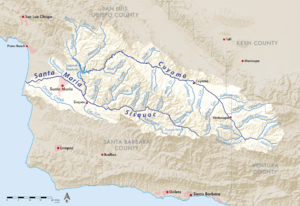Sisquoc River facts for kids
Quick facts for kids Siquoc River |
|
|---|---|

Stringer of Steelhead Trout on Upper Sisquoc River in 1916
|
|

Map of the Santa Maria River watershed, including the Sisquoc River
|
|
| Other name(s) | Arroyo De Siquico |
| Country | United States |
| State | California |
| Region | Santa Barbara County, San Luis Obispo County |
| Cities | Sisquoc, Garey |
| Physical characteristics | |
| Main source | Big Pine Mountain, Los Padres National Forest 6,320 ft (1,930 m) 34°41′42″N 119°38′17″W / 34.69500°N 119.63806°W |
| River mouth | Confluence with Cuyama River 354 ft (108 m) 34°54′11″N 120°18′45″W / 34.90306°N 120.31250°W |
| Basin features | |
| Tributaries |
|
| Type: | Wild |
| Designated: | June 19, 1992 |
The Sisquoc River is a river that flows west through northeastern Santa Barbara County, California. It joins the Cuyama River to form the Santa Maria River. This meeting point is near the border of Santa Barbara County and San Luis Obispo County, just north of Garey.
The Sisquoc River is about 57.4 miles (92.4 km) long. It starts high up on the north side of Big Pine Mountain. This mountain is part of the San Rafael Mountains, which are themselves part of the Transverse Ranges in California.
Contents
River's Name and History
The name "Sisquoc" comes from the Chumash language. It means "quail".
In 1846, an old map of the Rancho Cuyama area showed the river. On that map, it was called Arroyo de Siquico.
The Sisquoc River Watershed
A watershed is an area of land where all the water drains into a single river or stream. For the Sisquoc River, the Sierra Madre Mountains form the northern edge of its watershed. The San Rafael Mountains create the southern edge.
The first half of the river flows mostly northwest. This part is inside the Los Padres National Forest, specifically the San Rafael Wilderness. After leaving the National Forest, the river turns and flows west. It continues this way until it meets the Cuyama River. This meeting point is about 20 miles before the water reaches the Pacific Ocean.
The Sisquoc River flows freely, meaning there are no large structures blocking its path. There is one small, 3-meter dam on Horse Canyon, which is a tributary (a smaller stream that flows into the river). However, this dam is mostly filled with sediment (dirt and rocks). It does not stop the river's flow much. The Sisquoc River is special because it is part of the National Wild and Scenic Rivers System. This means it is protected for its natural beauty and importance.
Climate and Water Flow
The Sisquoc River watershed has a Mediterranean climate. This means it has hot, dry summers and mild, wet winters. The plants that grow here are mostly chaparral, which are tough shrubs that can handle dry conditions.
Most of the rain, about 95%, falls between November and April. The amount of rain can vary a lot, from 13 to 38 inches each year. Because there are no reservoirs (large lakes built to store water), the river can dry up during parts of the year. The dry conditions also mean that plants can become very dry. This creates a high fire hazard during the summer months.
River Ecology and Fish Life
The Sisquoc River is very important for Steelhead trout (Oncorhynchus mykiss). These fish are a type of rainbow trout that live in the ocean and swim up rivers to lay their eggs. Scientists believe that only about 1% of the original steelhead population is left. Most of the steelhead that used to swim up the Santa Maria River would continue into the Sisquoc River to spawn.
Many large dams on other rivers in Southern California, like the Santa Ynez, Ventura, and Santa Clara River, have blocked steelhead from reaching their homes. The Twitchell Dam was built on the Cuyama River in the late 1950s. This dam blocked over 264 miles of streams. It also blocked more than 60% of the Santa Maria River watershed where steelhead used to live. Because the Sisquoc River has no large dams, it is a very important place for the steelhead that are still alive.
Restoring Steelhead Habitat
Removing smaller dams on the Sisquoc River's tributaries can help steelhead. For example, a dam was built on Horse Creek (Horse Canyon) in 1968. This dam was 4.5 feet high and 60 feet wide. Over time, it created a drop of over 8 feet, which was too high for steelhead to jump over. The dam also filled up with sediment.
In 2006, this dam was removed using dynamite. By 2011, the sediment had naturally washed away. After the dam was gone, a beaver built a dam at the spot where Horse Creek meets the Sisquoc River. This beaver dam created a large pool of water. A fish biologist named Matt Stoecker saw many steelhead trout in this pool. Some of them were quite large, between 9 and 14 inches long.
Historically, California Golden beavers (Castor canadensis subauratus) lived in coastal streams in Southern California. A beaver specimen collected in 1906 from the Sespe River in Ventura County proves this. The Sisquoc River used to get steelhead from the Pacific Ocean through the Santa Maria River. However, the water taken by Twitchell Reservoir has made it harder for the steelhead to complete this journey.
Zaca Fire Impact
The Zaca Fire was a very large wildfire that happened in the summer of 2007. This fire burned a big part of the Sisquoc River watershed.

